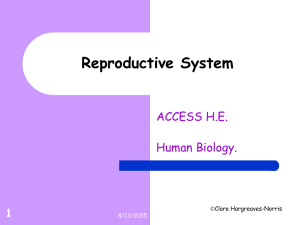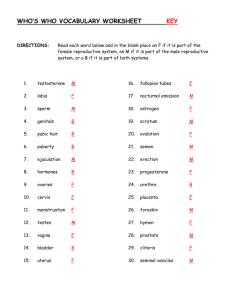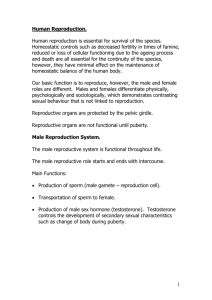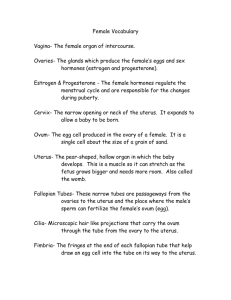Reproductive System
advertisement
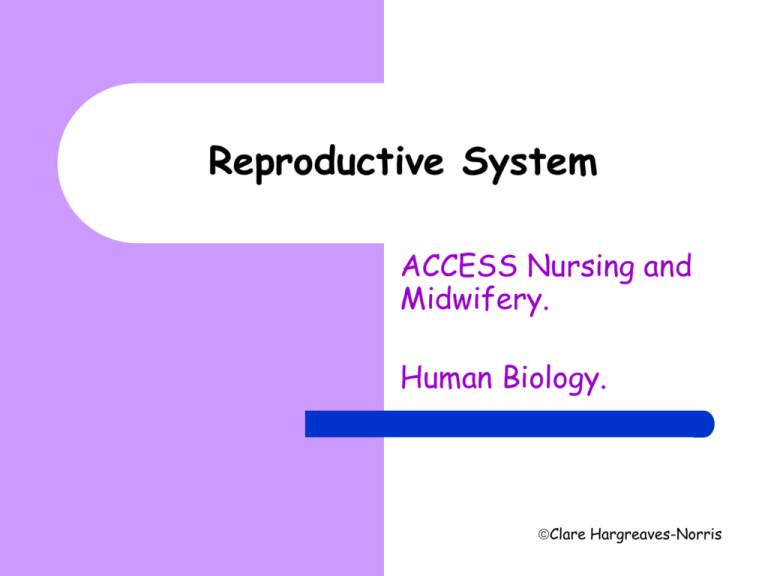
Reproductive System ACCESS Nursing and Midwifery. Human Biology. Clare Hargreaves-Norris Aims. Introduction. Male reproductive system A/P. Reference slide. Conclude with film clip. Clare Hargreaves-Norris Introduction Male and female reproductive systems are different in shape and structure, but both are specifically designed to produce, nourish, and transport either the ova or sperm. Male reproductive system is located both inside and outside the pelvis. Male reproductive system consists of: testes, duct system, accessory glands such as seminal vesicles and prostate, and the penis. Female reproductive system is located entirely in the pelvis. Female reproductive system consists of: ovaries, fallopian tubes, uterus, vagina, external genitalia,b (mammary glands). Clare Hargreaves-Norris Clare Hargreaves-Norris Testes Description Function • The two testes are ovalshaped and grow to about 5 centimeters in length and 3 centimeters in diameter. • They are suspended in the scrotum, outside the body. • Each testicle contain approximately 200-300 lobules. • Testes produce and store millions of sperm cells. • Testes are also part of the endocrine system, producing hormone testosterone. • Stimulates sperm production. • Testosterone is responsible for the development of the secondary sexual characteristics in boys (deeper voices, bigger muscles, body/facial hair). Clare Hargreaves-Norris Clare Hargreaves-Norris Duct system Description Function • Alongside the testicles are the epididymis and the vas Deferens. • These structures make up the duct system. • The vas deferens is a muscular tube that passes upward alongside the testes. • The epididymis is a set of coiled tubes inside each testicle. • The vas deferens provides a passageway that transports the semen from the testes. • The epididymis connects the testicle to the vas deferens. Clare Hargreaves-Norris Scrotum Description Function • The scrotum is a pouch-like • The scrotum helps to structure that hangs outside regulate the temperature of the pelvis. the testes. • It houses the • The temperature needs to be kept cooler than body epididymis and the testes. temperature to produce sperm. • The scrotum changes size and position to maintain the correct temperature. Clare Hargreaves-Norris Prostate gland Description Function • Surrounds the ejaculatory ducts at the base of the urethra, just below the bladder. • Produces semen. some of the Clare Hargreaves-Norris Seminal vesicle Description Function • Sac like glands that are found at the base of the bladder and are connected to the prostrate gland. • Provide fluids that lubricate the duct system and nourish the sperm. Clare Hargreaves-Norris Penis Description Function • • The penis, which usually hangs limp, becomes hard when a male is sexually excited. • Tissues in the penis fill with blood and it becomes stiff and erect. • The rigidity of the erect penis makes it easier to insert into the female's vagina during sexual intercourse. • When the erect penis is stimulated, muscles around the reproductive organs contract and force the semen through the duct system and urethra. • This process is called ejaculation. • Each ejaculation can contain up to 500 Clare Hargreaves-Norris million sperm. • • • The penis is actually made up of two parts: the shaft and the glans. The shaft is the main part of the penis and the glans is the tip. Inside the penis is the urethra, the channel that carries the semen to the outside of the body. At the end of the glans is a small slit or opening, which is where semen and urine exit the body through the urethra. Clare Hargreaves-Norris Clare Hargreaves-Norris http://www.youtube.com/watch?v=65BV5d XXxzM Clare Hargreaves-Norris Clare Hargreaves-Norris Ovaries Description Function • The ovaries are 2 oval• The ovaries produce, store, shaped organs that lie to and release ova into the the upper right and left of fallopian tubes in the the uterus. process called ovulation. • Each ovary measures about • The ovaries are also part of 4 to 5 centimeters in a the endocrine system grown woman. because they produce the • After puberty one ovum is female sex hormones released each month. estrogen and progesterone. • This process is called • These hormones are responsible for female ovulation. Clare Hargreaves-Norris secondary sexual characteristics. Clare Hargreaves-Norris Follicle. Small structures on the surface of the ovaries. The follicles contain fluid and an ovum. When an ovum is mature for fertilisation the follicle splits to release the ovum. The mature ovum then travels along the Fallopian tube to the uterus. Clare Hargreaves-Norris Fallopian tubes Description Function • There are 2 Fallopian • When an ovum exits an ovary, tubes, each attached to a it enters the Fallopian tube. side of the uterus. • Once inside the Fallopian • The Fallopian tubes are tube the ovum is transported about 10centimeters long towards the uterus by and about as wide as a peristalsis and tiny hairs piece of spaghetti. (cilia) in the tube's lining help • At the other end of each push the ovum down the Fallopian tube is a fringed narrow passageway toward area, (fimbriae ends), that the uterus. wrap around near the Clare Hargreaves-Norris ovary. Uterus Description Function • The uterus is shaped like an upside-down pear. • It has three layers: • Endometrium (mucus membrane – columna epithelial lining). • Myometrium (thick smooth muscle – thickest in the body). • Perimetrium (serous membrane). • Receives the fertilised ovum which develops in the uterus. • The uterus grows with the foetus until birth. • The muscle expands and contract to accommodate a growing foetus. • The muscle helps to push the baby out during labour. Clare Hargreaves-Norris Vagina Description Function • The vagina is a muscular, hollow tube that extends from the labia to the uterus. • Muscular walls enable it to expand and contract. • This allows the vagina to accommodate something as wide as a baby. • The vagina's muscular walls are lined with mucous membranes. • Lubricating fluids keep the vagina protected, moist and assist with penetration. • The vagina serves 2 purposes: • It is where the penis is inserted during sexual intercourse. • It is the pathway that a baby takes out of a woman's body during childbirth. Clare Hargreaves-Norris External genitalia Description Function • Mons pubis: The fleshy • Mons pubis and labia protect area located above the top the internal structures such of the vaginal opening. as the clitoris. • Labia (Major and Minor): Two pairs of skin flaps that protect the external genitalia and urethral orifice. • Clitoris: Small sensory organ located toward the front of the vulva where Clare Hargreaves-Norris the folds of the labia join. Mammary glands Description Function • The mammary glands are located in the breasts. • They consist of 15-20 glandular lobes. • Inside each lobe are several smaller lobules. • The mammary glands act as reservoirs for the milk. • They secrete the milk when stimulated during lactation. Clare Hargreaves-Norris Clare Hargreaves-Norris Clare Hargreaves-Norris Menstruation When a baby girl is born, her ovaries contain hundreds of thousands of ova. The ova remain inactive until puberty begins. At puberty the pituitary gland starts making hormones. The hormones stimulate the ovaries to produce female sex hormones, including oestrogen. The secretion of these hormones causes a girl to develop into a sexually mature woman. Clare Hargreaves-Norris Mensturation flows. Towards the end of puberty, girls begin to release ova as part of the menstrual cycle. Approximately once a month, during ovulation, an ovary sends a tiny ovum into one of the fallopian tubes. Unless the egg is fertilised by a sperm while in the fallopian tube, the progesterone levels drop causing the egg to dry up. The dried up ovum leaves the body about 2 weeks later through the uterus. This process is called menstruation. Blood and tissues from the endometrium of the uterus combine to form the menstrual flow. This which usually lasts from 3 to 5 days. On average, the monthly cycle for an adult woman is 28 days, but this may range from 23 to 35 days. Clare Hargreaves-Norris Dysmenorrhoea. Painful periods. Many women also experience abdominal cramps during the first few days of their period. These are caused by prostaglandin, a chemical in the body that makes the smooth muscle in the uterus contract. Clare Hargreaves-Norris Fertilisation Sexual organs of both sexes are required for reproduction. The female ovaries produce female gametes (ova). The male testes produce male gametes (sperm). Natural fertilisation occurs after sexual intercourse when the penis deposits seminal fluid into the vagina. The sperm have a tendency to swim towards the fallopian tube containing the ovulated ovum due to chemical signals that the sperm respond to. They are also assisted in their journey by the cilia that are located in the cervix, wafting them along. Once the sperm fuses with the ovum, the ovum membrane adjusts to prevent any other sperm from entering. Zygote is the name given to a fertilised ovum. The zygote develops into a foetus. Pregnancy will develop over a 40 week period. Clare Hargreaves-Norris



